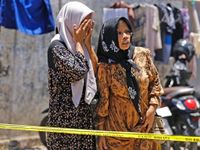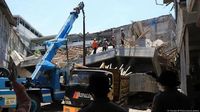It was supposed to be an ordinary afternoon at the Al Khoziny Islamic Boarding School in Sidoarjo, East Java, Indonesia. Students gathered for prayers, their voices echoing through the halls of a building that had stood since 1964. But as concrete was poured onto a newly constructed fourth floor, disaster struck. The building’s main support pillars, already strained by unauthorized expansion, gave way. Within moments, the upper stories crashed down onto the prayer hall below, trapping dozens of students beneath a mountain of rubble.
According to Indonesia’s National Disaster Management Agency, the collapse occurred on Monday, October 1, 2025. The school, a prominent pesantren with about 1,300 students from across the country, was in the midst of adding two new floors to its original two-story structure. However, as reported by the BBC and Associated Press, this expansion was carried out without the proper permits or adherence to construction standards—a fateful oversight that would soon have tragic consequences.
In the immediate aftermath, chaos reigned. Survivors described a scene of confusion and terror as the building crumbled around them. Most of the students trapped were boys in grades seven to twelve, aged between 12 and 19, gathered for afternoon prayers. Female students, who were praying in another part of the building, managed to escape unharmed, according to survivors interviewed by Reuters and DW.
Rescuers sprang into action, crawling through narrow tunnels and digging by hand to avoid further collapse. "We can't let our minds wander. Maybe there is still hope for our little brothers," said Yudhi Bramantyo, operations director at the disaster mitigation agency, as quoted by Reuters. Over 200 rescue workers, clad in signature orange uniforms, worked around the clock, their efforts watched anxiously by families gathered at the site. Ambulances stood by, and a whiteboard listed the names of survivors as they were found.
By Thursday morning, October 2, 2025, the grim reality set in. Despite deploying high-tech equipment—including thermal drones, sound detectors, and wall scanners—rescuers detected no further signs of life beneath the debris. The official death toll stood at five, with 58 or 59 students still missing and presumed dead, according to figures from AP and DW. More than 100 people had been rescued, most released from the hospital, though over two dozen remained hospitalized with serious injuries such as head trauma and broken bones.
Families faced an agonizing decision. With no hope of finding additional survivors, authorities sought consent from parents to begin using heavy machinery to clear the rubble. "We used high-tech equipment like thermal drones, and, scientifically, there were no more signs of life," explained Suharyanto, the head of the National Disaster Management Agency, during a news conference cited by DW. "In any case, we will be very, very careful when using the heavy machines," added Pratikno, Indonesia’s Coordinating Minister for Human Development and Cultural Affairs, speaking to reporters at the scene.
For parents like Mohammad Solehoddin and Ahmad Ikhsan, the wait was excruciating. Solehoddin, whose 17-year-old son Ahmad Suafi was among the missing, expressed a desperate hope: "By removing the large parts of concrete, we hope our sons will be found." Ikhsan, still holding out for news of his 14-year-old son Arif Affandi, told Reuters, "Until now, I haven't heard about my son. I believe my son is still alive." These stories, shared by AP and Reuters, reflect the anguish and resilience of families caught in the tragedy’s aftermath.
The rescue operation was a race against time, with nearly 220 workers on site by Thursday. Most rescues in disasters like this occur within the first 24 hours, and as days passed, the likelihood of finding survivors dwindled sharply. Still, the community clung to hope, holding joint prayer services and providing DNA samples to help identify the missing, as reported by The New York Times.
As investigations progressed, the cause of the collapse became painfully clear. The school’s expansion had not only lacked official permits but also disregarded basic engineering standards. The original foundation was never designed to support the additional weight of two new concrete floors. When workers began pouring concrete on the top floor, the main pillars buckled, triggering the catastrophic failure. Officials described this as a “technological failure,” a term that barely captures the magnitude of the loss.
The tragedy has prompted a national reckoning. Indonesia is home to more than 42,000 pesantren, serving millions of students, according to the Ministry of Religious Affairs. Many of these schools, often located in rural areas, operate with limited oversight and resources. Pratikno, the coordinating minister, promised a thorough review of safety regulations for Islamic boarding schools. “We will also coordinate with the Minister of Infrastructure to ensure that disasters like this won’t happen again,” he said during a news conference, as reported by The New York Times.
The Al Khoziny school itself, founded in 1964, has long been a respected institution, drawing students from across Indonesia. In the wake of the collapse, school officials issued an apology to families, calling the event an accident and asking for forgiveness. They joined parents in prayers for the missing, a small gesture of solidarity in a time of immense loss.
The numbers of missing fluctuated as authorities cross-checked school attendance lists with reports from families. Suharyanto, the disaster agency head, admitted, "We really hope that these 59 people are not there under the rubble. It happened previously that parents reported their children missing but turned out that their children were somewhere else — I do hope and pray that they are not there." Still, with each passing hour, hope faded further.
As cranes and excavators moved in, the focus shifted from rescue to recovery. The site, once filled with the sounds of prayer and learning, now echoed with the rumble of heavy machinery and the quiet sobs of grieving parents. The tragedy at Al Khoziny has laid bare the urgent need for stricter building standards and oversight in Indonesia’s vast network of religious schools. For the families of the missing, the pain is immeasurable; for the nation, a somber lesson lingers amid the ruins.

